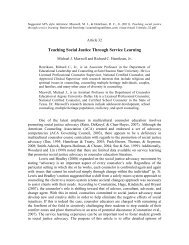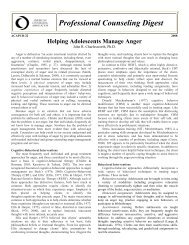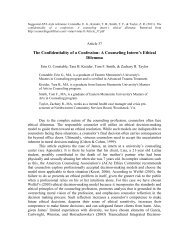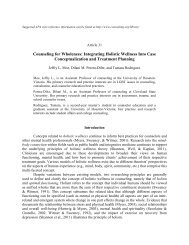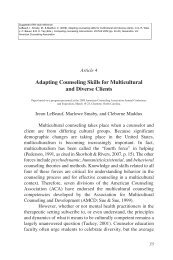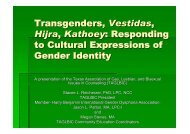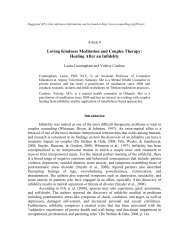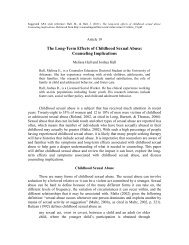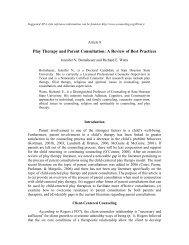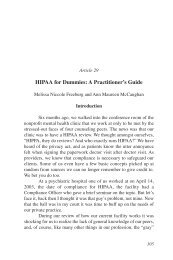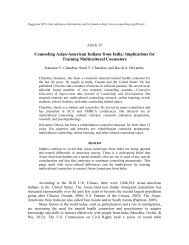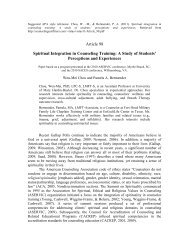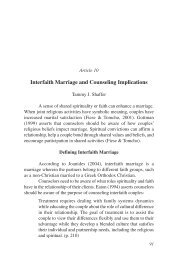Rational Emotive Spiritual Therapy - Counselingoutfitters.com
Rational Emotive Spiritual Therapy - Counselingoutfitters.com
Rational Emotive Spiritual Therapy - Counselingoutfitters.com
You also want an ePaper? Increase the reach of your titles
YUMPU automatically turns print PDFs into web optimized ePapers that Google loves.
VISTAS OnlineVISTAS Online is an innovative publication produced for the AmericanCounseling Association by Dr. Garry R. Walz and Dr. Jeanne C. Bleuerof Counseling Outfitters, LLC. Its purpose is to provide a means ofcapturing the ideas, information and experiences generated by theannual ACA Conference and selected ACA Division Conferences. Paperson a program or practice that has been validated through research orexperience may also be submitted. This digital collection of peer-reviewedarticles is authored by counselors, for counselors. VISTAS Online containsthe full text of over 500 proprietary counseling articles published from2004 to present.VISTAS articles and ACA Digests are located in the ACAOnline Library. To access the ACA Online Library, go tohttp://www.counseling.org/ and scroll down to the LIBRARYtab on the left of the homepage.n Under the Start Your Search Now box, you may searchby author, title and key words.n The ACA Online Library is a member’s only benefit.You can join today via the web: counseling.org and viathe phone: 800-347-6647 x222.Vistas is <strong>com</strong>missioned by and is property of the American CounselingAssociation, 5999 Stevenson Avenue, Alexandria,VA 22304. No part of Vistas may be reproduced without expresspermission of the American Counseling Association.All rights reserved.Join ACA at: http://www.counseling.org/
Article 27Introducing R.E.S.T.(<strong>Rational</strong> <strong>Emotive</strong> <strong>Spiritual</strong> <strong>Therapy</strong>):A 2,000 Year Old Healing ParadigmRick McKinneyIntroductionThe paradigm shift is on. Cartesian Dualism, the separation ofmind and body, has given way to Holism. The original 17th centurydeal between Descartes and the church giving jurisdiction of thehuman body to medicine and science while keeping the soul (mindand emotions) sacred for the church is null and void.Science hasproven that health of body and religion are inseparable and indivisible.Holism demands that the whole person—body, mind and soul—betreated in order to maximize healing.Such modern scientificpronouncements should be viewed as “gospel” to faith-believers whoare human service providers whether they work in church or nonchurchinstitutions. However, most faith-believers who work innonreligions institutions appear reluctant to use faith or spiritual basedinterventions. At the same time, human service providers in faith–based institutions routinely utilize non-faith interventions instead offaith–based interventions (exceptions include the use of churchdoctrine and prayer in counseling). Therefore this article is primarilyaddressed to professional counselors who are also persons of faithregardless of where they practice. A faith-based counseling methodwhich <strong>com</strong>bines the best of non-faith-based counseling methods withscientifically supported faith interventions which fits snugly intotwenty first century Holistic healing paradigms is introduced. This249
ief, spiritual, psychotherapeutic process is named R.E.S.T. (<strong>Rational</strong><strong>Emotive</strong> <strong>Spiritual</strong> <strong>Therapy</strong>).This article is to formally introduce, support and explain theorigin of R.E.S.T. counseling that the author has constructed anddeveloped over the past 25 years of practice in counseling and therapy.R.E.S.T. has successfully been used in both religious and nonreligiouscounseling settings such as hospitals, drug treatment programs, bothpublic and private schools, penal institutions, churches, and publicand private residential institutions for children and youth. Currently,R.E.S.T. is being used in all Philadelphia prisons, two State ofPennsylvania Community Correction facilities, a county prison, ahomeless shelter and post-release aftercare system for ex-offendersinvolving 93 faith institutions (churches, masjids and parishes).Composition of R.E.S.T. – Peripheral AspectsAlthough R.E.S.T. is eclectic, its two major <strong>com</strong>ponents representCognitive therapy and <strong>Spiritual</strong>-based (Faith-based) therapy.Therefore, R.E.S.T. is brief spiritual psychotherapy. The peripheralaspects of R.E.S.T. are represented by non-spiritual, medical orcognitive therapies such as those of Doctors Aaron Beck, Albert Ellis,Maxie Maultsby (cognitive therapy); Abraham Maslow (humanisticcounseling); Herbert Benson (relaxation therapy); and MiltonErickson (mind body information processing). R.E.S.T. utilizes a<strong>com</strong>bination of principles and techniques borrowed from cognitivetherapy and humanistic counseling propositions in conjunction withthe accumulated knowledge and understandings of the intricaterelationship between the mind, body and emotions (feelings, thoughtsand behaviors). These non-faith therapies have been strengthened bymedical/scientific mind body-based research such as that of Dr.Candice Pert and the work of modern medical spiritual practitionerssuch as Doctors Larry Dossey, Dale Matthews and others. However,the spiritual core (philosophy and healing techniques) of R.E.S.T.was developed through intense study of the life and work of Jesus,the First Century healer of Nazareth and founder of the ChristianReligion. This core is the focus of the latter part of this article.250
Research on <strong>Spiritual</strong> Interventions for Drug Abuse and ASPDAccording to Dr. Benson from a lead article introducing theMind/Body Medical Education Initiative: “violence, impulse control,substance abuse, poor academic performance, and an increasednumber of suicide attempts are among the many problems . . . thatcan be mediated by the inclusion of spirituality in therapy.” In researchfrom the John Templeton Foundation (Matthews, Larson, Saunders,& Barry, 1993), alcohol, nicotine and drug use were reduced in nearly100 percent of the studies where “Faith Factors” were utilized intreatment. (The John Templeton Foundation seeks to promote a deeperunderstanding of the influence of spirituality, beliefs and values haveon human health. By promoting collaboration and clinical researchinto the relationship between spirituality and health and documentingthe positive medical aspects of spiritual practice, the foundation hopesto contribute to the reintegration of faith into modern life.)The <strong>Spiritual</strong> Core of R.E.S.T.The decision to establish Jesus as the core philosopher/practitioner model of the R.E.S.T. healing process had nothing to dowith religious doctrine or dogma. It was based on the effectivenessof the Jesus model and its ability to enhance other professional andmedical models. We need no more than the historical record of theTalmud, Koran, Josephus and the synoptic gospel record to acceptthe status of Jesus as a great and successful healer. The goal was todevelop a modern model <strong>com</strong>prised of the best modern psychological/medical interventions and the best spiritual interventions fromantiquity. Of all religions, and of all religious leaders, none—Mohammad, Confucius, Toa, etc.—had the historical, written recordof successful healing, as did Jesus.Jesus was the world’s greatest healer—(He still holds thatdistinction). His existence as a great healer and exorcist has beenverified by secular and sacred history. This is verified by objective,modern research into the life of Jesus by several world-renownedbiblical scholars and researchers representing many points of view.251
The best known of these scholarly explorations into the life and workof Jesus is a group that is called the Jesus Seminar.With such a battery of successful healing out<strong>com</strong>es as portrayedin the synoptic gospel record, humans tend toward disbelief whenthere is no plausible or rational explanation. We say to ourselves,“Wow! If this is true, it is awesome!” or we think, “This is too goodto be true,” and of course everybody knows when something is toogood to be true, it is usually because it is not true. Was the work ofJesus random or did it have design? Were there describable techniquesand a routine methodology? If so, can those techniques andmethodology be understood and replicated for more efficient healingpractices today? The author believes the answer to these questions is“yes.” R.E.S.T. is designed and built around both the routinemethodology and the healing techniques of Jesus as illustrated in thesynoptic gospels.Studying the life and teachings of Jesus lead this author to focusthe spiritual core of R.E.S.T. therapy, on his principles, methods andtechniques that were uncovered from analyzing his work. Ininvestigating his healing work, the case method was used to analyze,<strong>com</strong>pare and contrast each of his healing cases, which the authorshares in the soon to be published book, “The Clinical Jesus, theDoctor Who Never Lost a Case.” Those findings are shared as a meansof explaining and documenting the historical relevance of the R.E.S.T.process. The presentation of these finding is intended to reflect theauthor’s belief that the healing work of Jesus represented both scienceand religion. It is intended to also firmly establish that the basis forholistic medicine must include spiritual or faith-based therapy, ifmodern medical therapy is to reach the levels of healing it has thepotential to reach.Therefore, to properly present R.E.S.T., it is necessary to laybare in writing the spiritual therapy (healing methods) of Jesus.Although he was a great healer, so much attention has been given tothe other aspects of his life that his healing ministry and activitieshave been grossly underemphasized and underrepresented in print.Healing was the activity or ministry that he engaged in the most, andwas the foundation for his reputation. Even when his healing activities252
have been written about, they have been shrouded in mystery,mysticism or fantasy. Recent advances in medical science provideinformation that enables discussion of Jesus as a healer from a modernunderstanding of psychotherapy that recognizes the bio-neuralhappenings of healing and the inter-connectedness of mind and bodyin the healing process.Consistency of Treatment MethodsExamination of 26 client cases of Jesus reveals that heconsistently employed the same selected interventions or omitted thesame interventions based on his diagnosis. He diagnosed clientsaccording to what type of sickness the client was experiencing,whether the illness was psychological/emotional (three cases),physiological (fourteen cases), psychiatric (six cases) orpsychosomatic (three cases). He employed faith-based questions inhis assessments and therapeutic treatment interventions such as: 1)talk/dialogue, including parables, metaphors and similes; 2) questions;3) touch therapy; 4) directives; 5) information therapy or edu-therapy;6) medication and; 7) internal dialogue or subconscious informationprocessing.Medical science is assisting us to begin to understand how heac<strong>com</strong>plished some of the healing that he preformed, which turnsout to be excellent sound psychotherapy. Questions of where heacquired this knowledge and these skills of healing are still mysteriesof history and matters of faith. The real miracle is that he possessedsuch knowledge and skill centuries ahead of his time.Major Contributions of Jesus as Healer to the 21 st CenturyHealing represents change from a pathological or broken stateto a restored or whole state. Most forms of change are met with greatopposition. Jesus represented healing, which represented change.The implications of that change were staggering. He went beyondtradition and the use of healing techniques. He plunged into thesubstance of a new worldview and expanded the view of disease and253
illness as being tied to cultural and societal implications. Althoughthe opposition he faced was awesome, he successfully used his healingministry to address sick social issues, the results of a sick society.Included among these sicknesses were discrimination and prejudiceagainst women, the sick and diseased, and persons of othernationalities. He healed publicly, without charge and without regardto sex, race or religious preference. He provided free medical servicefor any and all who were afflicted, an important model for the twentyfirst century.Other major contributions that the clinical Jesus offers moderntherapy, including medical therapies, pertains to holistic relationships.Two such relationships are the relationships between belief andimmune function, and the relationship between self-esteem andillness. His doctrine of the Fatherhood of God and the brotherhoodof all humans has profound social implications in providing healingfor millions of hurting persons, many of whom are fatherless,homeless, and who feel abandoned and betrayed by society. Researchidentifies much social pathology associated with feelings ofdetachment and societal alienation. These feelings, apparent in thelives of many inner city children, lead many of these children intoself-medicating with drugs and antisocial behavior. This could bereversed (healed) with the application of <strong>Spiritual</strong> Healinginterventions such as the belief of God as Abba, or Universal Fatherof all mankind. Jesus even taught his students to pray, “Our Father,who is in heaven.” The fatherhood spiritual belief has the power as aspiritual intervention to heal many hurting children who are tuckedaway in our society in foster care or other residential programs.Therefore in R.E.S.T. we seek the healing of anti-social orbehaviorally disordered populations through means of spiritualadoption and integration into religious <strong>com</strong>munities.R.E.S.T. Methodology–Combining of Cognitiveand <strong>Spiritual</strong> <strong>Therapy</strong>Cognitive therapy techniques are directed at changing selfdestructivebehaviors by identifying and changing cognitions, beliefs254
and self-destructive thoughts. In R.E.S.T. these self-destructivethoughts (SDT) are identified and replaced with spiritual-basedthoughts (SBT) to achieve spiritually-based behaviors.R.E.S.T. is therefore especially geared to free men, women andyouth from the ravages of drug and alcohol addictions and/or frombeing controlled by negative emotions such as anger, depression,anxiety, guilt, worry, shame and perfectionism. The client’s newthoughts, feeling and behaviors have the force of spiritual morality.Deliverance from these negative behaviors (drug use and crime) is<strong>com</strong>parable to exorcism in the New Testament healing practices ofJesus, when clients were delivered from satanic possession and controlof their mind body. The client’s new spiritual thoughts can be of anyreligion or religious belief, but they must have the force of beingconnected with a Spirit Being—God. Since most humans profess abelief in God it is not necessary to reconstruct the clients’ God-relatedbeliefs, only to identify them, strengthen them with metaphors andreframe and utilize them as spiritual replacement thoughts (SRT).This intervention, which we call trace, erase and replace, empowersthe client by disabling the irrational SDT which was producing hisproblematic behavior.Other populations exposed to the R.E.S.T. therapeutic processwith successful out<strong>com</strong>es have been troubled and in-trouble youth,both institutionalized and non-institutionalized youth with emotionalproblems or with behavioral records. R.E.S.T. counseling techniqueseffectively address the irrational thinking that supports acts of violence(including domestic violence), gang membership, impulsive criminalactivities and school problems/disruptions. In presenting an exampleof the goal of R.E.S.T. for antisocial populations, a useful metaphoris of religious conversion as a form of basic behavior modification,where the client’s pathological or antisocial thought “do others beforethey do you” is traced, erased and replaced with the spiritual thought:“do unto to others as you would have them do unto you.”255
SummaryR.E.S.T., a brief cognitive-spiritual psychotherapeutic counselingmethod, is available for use by counseling professionals who are faithbelieverswhether they work in religious or secular human serviceinstitutions. R.E.S.T. is a <strong>com</strong>bination of rational therapies withscientifically supported spiritual or faith-based interventions. At thecore of R.E.S.T. is the philosophy and healing methods of Jesus. Themethodology of R.E.S.T. involves a battery of varied techniquesincluding metaphors, reframing, etc., in order to trace, erase andreplace self-destructive thoughts which support unwanted or sociallyunacceptable behaviors with spiritual replacement thoughts whichproduce spiritually dynamic (moral/socially accepted) behaviors.ConclusionBecause of the proliferation of antisocial behavior, drug abuseand criminal activities, the federal government believes (and hasevidence) that faith-based institutions and faith volunteers could playa significant role in addressing (abating and diminishing) antisocialbehaviors. Science supports the <strong>com</strong>bined usage of “Prayer andProzac” as a holistic approach to behavior modification. If the faithworld is being solicited for their assistance and faith-basedinterventions are being validated as effective tools in mental healththerapy, then it is reasonable to conclude that faith therapies such asR.E.S.T. should be officially brought to the table and tested for efficacyand effectiveness. To date, we do quantitative evaluation of R.E.S.T.<strong>com</strong>pleters to determine recidivism among both incarcerated andreleased inmates attempting to reintegrate into the <strong>com</strong>munity. During2002, more than 800 inmates successfully <strong>com</strong>pleted a 12 to 14 weekR.E.S.T. group therapy program. Initial records have identified thatof the first 200 to be released into the <strong>com</strong>munity, 18 months lateronly 28 percent had recidivated. However, empirical longitudinalresearch is needed in order to better establish why and how R.E.S.T.faith-based counseling, employed by people of faith, works forantisocial, addicted and forensic populations.256
ReferencesBenson, H. (1996). Timeless healing: The power and biology of belief.New York: Scribner Publishers.Dossey, L. (1999). Reinventing medicine: Beyond mind-body to anew era of healing. New York: HarperCollins.Dossey, L. (1989). Recovering the soul: A scientific and spiritualsearch. New York: Bantam Books.Dossey, L. (1982). Space, time & medicine. Boston: ShambhalaPublications.Dryden, W., & DiGiuseppe, R. (1990). A primer on rational emotivetherapy. Champaign, IL: Research Press.Ellis, A. & Harper, R. A. (1975). A new guide to rational living. NorthHollywood, CA: Wilshire Book Company.Koenig, H. G., McCullough, M. E., & Larson, D. B. (2001). Handbookof religion and health. New York: Oxford University Press.Matthews, D.A., Larson, D.B., Saunders, D.M., & Barry, C.D. (1993).The faith factor: An annotated bibliography of clinical researchon spiritual subjects. [S.l.]: National Institute for HealthcareResearch.Matthews, D. A., & Clark, C. (1998). The faith factor: Proof of thehealing power of prayer. New York: Viking.Pert, C.B. (1997). Molecules of emotions. New York: Scribner Press.Powell, M. A. (1998). Jesus as a figure in history: How modernhistorians view the man from Galilee. Louisville, KY:Westminster John Knox Press.257
Rossi, E. L. (1986). The psychobiology of mind-body healing. NewYork: W.W. Norton & Company.258



